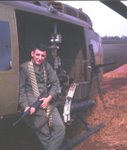
Dawn C/A just after engine start


C/A’s usually consisted of a flight of two or more Huey’s and sometimes involved our entire company. This is how we did it:
The make-up of a C/A consisted of the C and C (command and control) aircraft and was usually flown by our company commander or experienced platoon leader. Rank was not really a consideration due to the fact that a Major, newly arrived in country with little combat experience might be assigned to the C and C aircraft but the actual function of directing the C/A would revert to the other pilot while the higher ranking officer observed, shared flying duties and learned. Sometimes the C and C duties went to a WO-1 with considerable combat flight experience and proven leadership. C and C would orbit above the C/A and direct the flight path headings, altitude, airspeed and anything else requiring our attention.
Flight lead, or the first aircraft in the C/A was always assigned to an experienced pilot regardless of rank and the main consideration was that he be a “smooth stick”. Flight leads had to fly fluid, gentle flight paths because his control inputs and resulting attitude changes were amplified the further back in the formation you were flying. A flight lead that was rough on the controls, or would not hold constant altitude or headings made it miserable for the rest of the flight to remain in formation.
Tail end Charlie or the last bird in the C/A also had to be an experienced pilot. This pilot was always an aggressive stick that could adjust constantly to the whip effect the further back in the formation you were. Tail end Charlie also needed to have proven leadership abilities as he was in a position to observe the entire flight in front of him and advise the flight lead as to when formation changes were complete. He also had the responsibility to pick up the crews of any aircraft shot down during the C/A
The rest of the aircraft assignments mixed an experienced A/C, “aircraft commander” with a new or less experienced pilot.
A C/A would normally begin for us well before dawn so we could get some breakfast, attend the pilots meeting for final details of the C/A, pre-flight and move the aircraft from the revetments to the correct position on the staging area to the side of the runway. The grunts would arrive by truck and wait for the command to load up. We’d then man the aircraft and wait for the signal to start engines. We normally cranked when the C and C aircraft launched as this was normally the pre-arranged signal. This was when the grunts boarded up. We maintained radio silence and waited for C and C to call for the check in. We’d start with flight lead and work our way back to "Tail end Charlie." If a bird went down at this point for whatever reason, the standby aircraft, (if one was available) would load the downed aircraft grunts and join the flight just in front of tail end charlie when we launched.
C and C would then call for lead to launch the flight. Lead would call the tower for takeoff clearance. By now we were all light on the skids, (flight RPM and enough collective pitch to almost hover) and lead would initiate the launch. We’d launch as a flight and start the climb to the prearranged mission altitude. At this point, C and C would call for the flight to go to “V’s of three”, “staggered trail”. (right or left) or whatever formation suited the LZ. C and C would guide the flight to the IP, (initial point) call the turn to the LZ and change the formation if necessary.
At this point, the gun ships joined us and went ahead of the flight to “prep” the LZ. The UH-1C Hueys or AH-1G Cobras would make their runs down either side of the LZ and hose it down with mini-gun, 40 mm grenade launcher and 2.75 inch rockets.
By this time the flight was on short final to the LZ and the most dangerous part of the C/A as we were low, slow and not changing direction. We were a stationary, ever increasing size target for the gooks that shot at us. The Hueys would land and unload the grunts who would take up a defensive perimeter, then quickly clear the LZ for the next aircraft to land. We took the most fire when landing and departing the LZ and lost a number of aircraft in or close to the LZ.
At times, we would do a “false insertion” and fly the entire C/A as described above to a bogus LZ but not unload the grunts. This supposedly would fool the gooks and maybe it did. What it did for certain was increase our workload and use up a lot of fuel and ordinance for the gun ships.
We’d form up in a tactical formation and return to base camp to re-fuel, re-arm and assume regular mission assignments. Several birds would fly re-supply to the unit we inserted to deliver C’s and ammo or whatever they needed.
C/A’s took a lot of planning and practice to execute well. Timing was critical and flight discipline a must. A well executed C/A got the aircraft in and out, the grunts unloaded and the LZ secured without loss of life or aircraft.



No comments:
Post a Comment